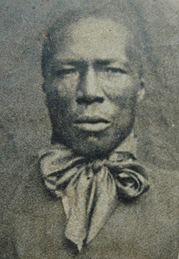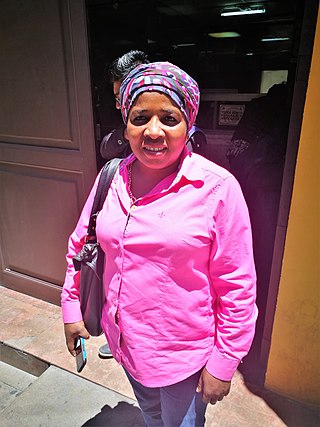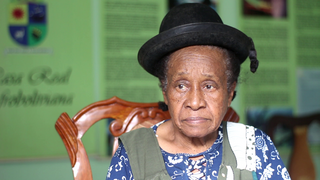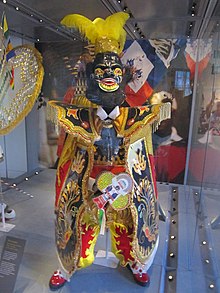The music of Bolivia has a long history. Out of all the Andean countries, Bolivia remains perhaps the most culturally linked to the indigenous peoples.
Peruvian music is an amalgamation of sounds and styles drawing on Peru's Andean, Spanish, and African roots. Andean influences can perhaps be best heard in wind instruments and the shape of the melodies, while the African influences can be heard in the rhythm and percussion instruments, and European influences can be heard in the harmonies and stringed instruments. Pre-Columbian Andean music was played on drums and string instruments, like the European pipe and tabor tradition. Andean tritonic and pentatonic scales were elaborated during the colonial period into hexatonic, and in some cases, diatonic scales.
Afro–Latin Americans or Black Latin Americans are Latin Americans of full or mainly sub-Saharan African ancestry.

Afro-Ecuadorians or Afroecuatorianos (Spanish), are Ecuadorians of predominantly Sub-Saharan African descent.

The Caporales is a traditional Andean dance originated in Los Yungas of La Paz. Caporales were created and presented to the public for the first time in 1969 by the Estrada Pacheco brothers, who were inspired in the character of the 'Caporal' who is the overseer of the black slaves and was usually mixed race, wore boots and held a whip, a dance that belongs to the region of the Yungas, Bolivia The dance, however, has a prominent religious aspect. One supposedly dances for the Virgin of Socavón and promises to dance for three years of one's life. Caporal or caporales today is a folklore dance very popular in the festivities of not only Bolivia, but also Argentina, Chile, Peru, Spain and the United States.

The Carnival of Oruro is a religious and cultural festival in Oruro, Bolivia. It has been celebrated since the 18th centur in the Peruvian virreynato. Originally an indigenous festival, the celebration later was transformed to incorporate a Christian ritual around the Virgin of Socavón. The carnival is one of UNESCO's Masterpieces of the Oral and Intangible Heritage of Humanity.
The Morenada is an Andean folk dance whose origins are still under debate. This dance is practiced mainly in Bolivia as well as in Peru and in recent years with Bolivian immigration in Chile, Argentina and other countries.

DonJulio Pinedo is the ceremonial king of the Afro-Bolivian community of the Nor Yungas province, crowned in 1992, forty years after the death of the previous king, his grandfather Bonifacio Pinedo. His coronation took place during a Catholic ceremony in the chapel at the hacienda of the Marquis de Pinedo.

DonBonifacio Pinedo was the King of the Afro-Bolivians from 1932 to 1954. As the ceremonial king, he presided over religious festivities celebrating Saint Benedict the Moor and was responsible for matchmaking in the Afro-Bolivian community. His role was suppressed during the Bolivian National Revolution.

Afro-Chileans are Chilean people of African descent. They may be descendants of slaves who were brought to Chile via the trans-Atlantic slave trade, or recent migrants from other parts of Latin America, the Caribbean or Africa.
The Saya is a music and dance that originated in Los Yungas-Chicaloma Bolivia. The artform's name comes from the Kikongo term nsaya, which means communal work led by a singing voice, akin to a work song. The Saya's instrumentation and dance also reflects the influence of traditional Andean music.
Camba is a word historically used in Bolivia to refer to the indigenous population in the eastern tropical region of the country, or to those born in the area of Santa Cruz, Beni, and Pando. Nowadays, the term "Camba" is used predominantly to refer to eastern Bolivian populations of mixed Spanish, Chane, and other indigenous Amazonian descent born in the eastern lowlands in and around Santa Cruz de la Sierra.

Bolivians are people identified with the country of Bolivia. This connection may be residential, legal, historical or cultural. For most Bolivians, several of these connections exist and are collectively the source of their being Bolivian.

Adalberta Mónica Rey Gutiérrez is an Afro-Bolivian cultural leader and activist whose anthropological research helped pass legislation for formal recognition of Afro-Bolivians as an ethnic category in the census of the country. After serving as an educator and cultural activist for many years, she went to work in the government. She is currently a supranational delegate in the Plurinational Legislative Assembly of Bolivia.
The Afro-Bolivian Royal House is a ceremonial monarchy recognized as part of the Plurinational State of Bolivia, which does not interfere with the system of the Presidential republic in force within the country. It is centred in Mururata, a village in the Yungas region of Bolivia. The monarchy is treated as a customary leader of the Afro-Bolivian community.

Jorge Medina Barra was a Bolivian civil rights activist and politician who served as a member of the Chamber of Deputies from La Paz, representing its special indigenous circumscription from 2010 to 2015.
Mururata is a village in the tropical valleys of the Bolivian Yungas. It is a centre of Afro-Bolivian culture, and of the ceremonial Afro-Bolivian monarchy.

DoñaAngélica Larrea is the Ceremonial Queen of the Afro-Bolivians, as the wife of Ceremonial King Julio Pinedo. She twice served as the mayor of Mururata.

DoñaAurora Pinedo was the Princess Regent of the Afro-Bolivians from 1954 to 1992. As her father, Bonifacio I, had no male heirs, she succeeded him as princess regent following his death in 1954.


























